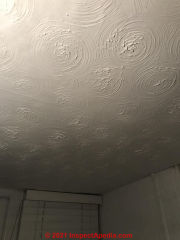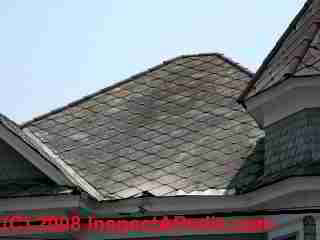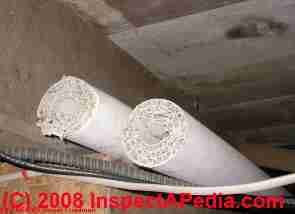 Identify Asbestos-Containing Material
Identify Asbestos-Containing Material
Easy Steps to Decide if a Building Product Probably Contains Asbestos
- POST a QUESTION or COMMENT about how to identify asbestos-containing flooring materials and what to do when asbestos-containing floor tiles or sheet flooring are found in a building.
Does this material in or on my building contain asbestos? Easy questions can help you decide if a material may contain asbestos, or not - a precursor to deciding to have a material tested for asbestos, or simply to treat the material as presumed to contain asbestos.
This article series explains how to products that are likely to contain asbestos, by making a simple visual inspection, noting the probable age of the building and age of its materials, and similar clues.
Asbestos is safe and legal to remain in homes or public buildings as long as the asbestos materials are in good condition and the asbestos can not be released into the air.
InspectAPedia tolerates no conflicts of interest. We have no relationship with advertisers, products, or services discussed at this website.
- Daniel Friedman, Publisher/Editor/Author - See WHO ARE WE?
Make a Reasonable Asbestos-Containing Material Guess in 5 Easy Steps
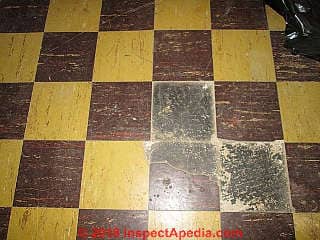
If you don't want to or cannot have a sample of your asbestos-suspect material tested, answer the easy questions below to make a reasonable guess at whether or not the floor contains asbestos.
Generally the safest and most-economical approach is to leave asbestos-suspect materials in place, covering it over. In that case you do not need to test a sample of your material for asbestos.
However IF you must demolish the material AND you cannot remove it without creating a dusty mess, STOP and either treat the product as presumed to contain asbestos or have a sample tested.
First priority: don't make a dusty mess: many building materials can produce harmful dust, regardless of whether the material contains asbestos.
Some products such as the corrugated asbestos paper pipe insulation shown at the top of this page can be identified by visual inspection as there really was not another identical-looking pipe insulation product made without asbestos. This asbestos pipe insulation is friable and should not be disturbed.
For other materials, before having the material tested, answering some basic questions or giving context information can help make a reasonable guess at whether or not the material contains asbestos.
Second priority: don't panic about possible asbestos in a material. Panic itself can be a health hazard and can also be a financial hazard.
If a material is not friable and is in good condition, even if it contains asbestos it's not likely to be releasing asbestos into the building air; usually the best course of action is to leave such material alone, in place, and to cover it over to prevent damage.
Our photo above shows vinyl-asbestos or asphalt-asbestos floor tiles from the 1960s, some missing, others broken or in poor condition. Don't create a dusty demolition mess of such a floor. If a floor like this can not be left in place and simply covered, then there are safe-removal procedures that can and should be followed.
[Click to enlarge any image]
These Context-Questions Help Assess the Chances that a building Material Contains Asbestos
- What is the AGE of the building & of the material?
Determine or guess at the building age, years when remodeling was done, year when flooring, wall paneling, ceiling tiles, or other material or building products in question (of asbestos content) was installed.
Compare the possible material age to the year in which asbestos-containing versions of that material or product were no longer sold in your country.
For example, in North America if asphalt or vinyl floor tiles or sheet flooring or ceiling tiles or drywall and joint compound were made or installed before 1986, treat the material as presumed to contain asbestos.
For many common building materials we provide specific asbestos-product identification guides - found at the end of this article.
Above: textured ceiling paint that was applied in a building in the 1970s may contain asbestos.
- What is the product type: for example, for paints and coatings that might contain asbestos, consider the coating age, type, purpose, and surface to which it was applied.
For example, popcorn ceiling paint, textured paints, and fire-resistant paints and coatings sold before asbestos was banned in your country may contain asbestos.
Some products were well known as containing asbestos over many years, such as many asbestos-cement board products, asphalt- or vinyl-asbestos flooring products, while other products such as fiberboard made from plant fibers would not be expected to contain asbestos.
- What is the Product Pattern and Size: match against pattern guides given in the indexes cited in
our INDEX to RELATED ARTICLES.
Guides to specific asbestos-containing products like ceiling tiles, floor coverings, etc. are given at the end of this article.
- Look for a manufacturer's brand, pattern name, number, style
If accessible, look for stampings or markings on the product, or if available, on the flooring box or packaging.
Occasionally we can find extra material (floor tiles, ceiling tiles, insulation), stored in an attic, basement, or garage.
If you have such packaging, take a look at the packaging, box brand, label, style or pattern.
Often the manufacturer and product or serial number can identify flooring in exquisite detail.
If you can not see a brand name or pattern for your asbestos-suspect product, as you usually won't, try the steps given below.
- Lab testing of flooring for asbestos content: if you face a costly dusty messy demolition it may indeed be appropriate to have a sample of the material tested.
If you have time and about $40. U.S.D. you can also have a flooring sample tested for asbestos using one of the certified asbestos testing labs in
this ASBESTOS TESTING LAB LIST.
So Does This Building Material Contain Asbestos or Not?
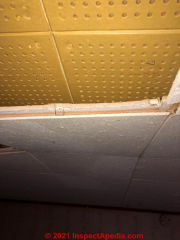
The most-common question we receive from readers, often along with a photo of flooring, ceiling tile, drywall, or pipe insulation is "Do you think this contains asbestos?"
In our photo we see two layers of acoustic ceiling tiles dating to the 1940s. These ceiling tiles might contain asbestos.
The Short Answer: treat old building materials that might contain asbestos as PACM - Presumed Asbestos Containing Material
The age of building and of the specific building product as well as country location all figure into a guess about whether or not it is likely to contain asbestos.
Friable asbestos-suspect materials
If an asbestos-suspect material is soft enough that you can create a powdery dust by mashing it between thumb and forefinger, it's friable. Leave such materials alone, un-disturbed.
If testing confirms that the material contains asbestos it may be best to encapsulate it in place or on occasion, such in an area where the material can't be protected from damage, it should be removed by a licensed, trained asbestos abatement contractor.
Non-Friable asbestos suspect materials
Intact, un-disturbed by sanding, grinding, sawing, chopping, etc., asbestos-containing material such as flooring and many ceiling products or drywall are not friable - the material does not readily release detectable levels of harmful asbestos into the air of the building where it is installed.
When possible the safest, least expensive, and most-recommended approach is to leave the material alone, in place, and to seal or cover it over with a new layer of material.
Photo above: asbestos cement roof shingles on a 1940s home in Port Jervis, New York. These shingles are not friable but may shed asbestos by weathering, power washing, or during demolition.
...
Continue reading at ASBESTOS IDENTIFICATION IN BUILDINGS - home, or select a topic from the closely-related articles below, or see the complete ARTICLE INDEX.
Or see these
Recommended Articles
- ASBESTOS CEILING TILE IDENTIFICATION - 5 Easy Steps to tell if CEILING TILES are likely to contain asbestos
- ASBESTOS DISPOSAL REGULATIONS
- ASBESTOS FLOORING HAZARD LEVEL ASSESSMENT
- ASBESTOS FLOORING HAZARD REDUCTION - steps to take to protect the floor or cover it over.
- ASBESTOS IDENTIFICATION IN BUILDINGS - home
- ASBESTOS in CEILING TILES
- ASBESTOS in CEILING or WALL PAINT
- ASBESTOS CEMENT SIDING
- ASBESTOS in DRYWALL
- ASBESTOS in DRYWALL MUD - TEST LOCATIONS
- ASBESTOS in DRYWALL TAPE?
- ASBESTOS in FIBER CEMENT ROOFING
- ASBESTOS in FIBERBOARD
- ASBESTOS in PLASTER
- ASBESTOS LIST of PRODUCTS
- ASBESTOS PIPE INSULATION
- ASBESTOS PHOTO GUIDE to MATERIALS
- ASBESTOS PRODUCTS BANNED vs PERMITTED U.S. 2023
- ASBESTOS PRODUCING COMPANIES & TRUSTS
- ASBESTOS REMOVAL, WETTING GUIDELINES
- ASBESTOS RISK ASSESSMENT
- ASBESTOS TESTING LAB LIST - how to get an asbestos test
- COMMON OCCURRENCES OF ASBESTOS - in or on buildings
- ASBESTOS CEILING TILE IDENTIFICATION - 5 Easy Steps to tell if CEILING TILES are likely to contain asbestos
- DOES THIS FLOOR CONTAIN ASBESTOS? - 5 easy questions to tell if your FLOOR probably contains asbestos -
- DOES THIS MATERIAL CONTAIN ASBESTOS? - 5 easy questions to tell if a BUILDING MATERIAL probably contains asbestos -
- FIBERBOARD SHEATHING ASBESTOS CONTENT
- FIBERGLASS ASBESTOS COMBINATIONS
- VERMICULITE INSULATION ASBESTOS
Suggested citation for this web page
DOES THIS MATERIAL CONTAIN ASBESTOS? at InspectApedia.com - online encyclopedia of building & environmental inspection, testing, diagnosis, repair, & problem prevention advice.
Or see this
INDEX to RELATED ARTICLES: ARTICLE INDEX to ASBESTOS HAZARDS
Or use the SEARCH BOX found below to Ask a Question or Search InspectApedia
Ask a Question or Search InspectApedia
Try the search box just below, or if you prefer, post a question or comment in the Comments box below and we will respond promptly.
Search the InspectApedia website
Note: appearance of your Comment below may be delayed: if your comment contains an image, photograph, web link, or text that looks to the software as if it might be a web link, your posting will appear after it has been approved by a moderator. Apologies for the delay.
Only one image can be added per comment but you can post as many comments, and therefore images, as you like.
You will not receive a notification when a response to your question has been posted.
Please bookmark this page to make it easy for you to check back for our response.
IF above you see "Comment Form is loading comments..." then COMMENT BOX - countable.ca / bawkbox.com IS NOT WORKING.
In any case you are welcome to send an email directly to us at InspectApedia.com at editor@inspectApedia.com
We'll reply to you directly. Please help us help you by noting, in your email, the URL of the InspectApedia page where you wanted to comment.
Citations & References
In addition to any citations in the article above, a full list is available on request.
- In addition to citations & references found in this article, see the research citations given at the end of the related articles found at our suggested
CONTINUE READING or RECOMMENDED ARTICLES.
- Carson, Dunlop & Associates Ltd., 120 Carlton Street Suite 407, Toronto ON M5A 4K2. Tel: (416) 964-9415 1-800-268-7070 Email: info@carsondunlop.com. Alan Carson is a past president of ASHI, the American Society of Home Inspectors.
Thanks to Alan Carson and Bob Dunlop, for permission for InspectAPedia to use text excerpts from The HOME REFERENCE BOOK - the Encyclopedia of Homes and to use illustrations from The ILLUSTRATED HOME .
Carson Dunlop Associates provides extensive home inspection education and report writing material. In gratitude we provide links to tsome Carson Dunlop Associates products and services.


